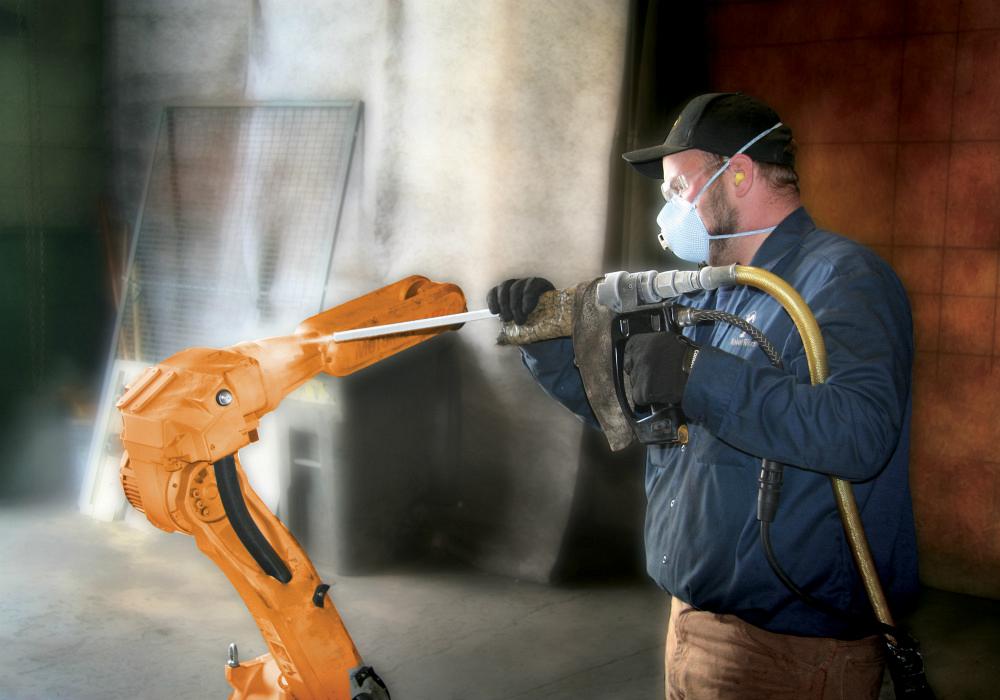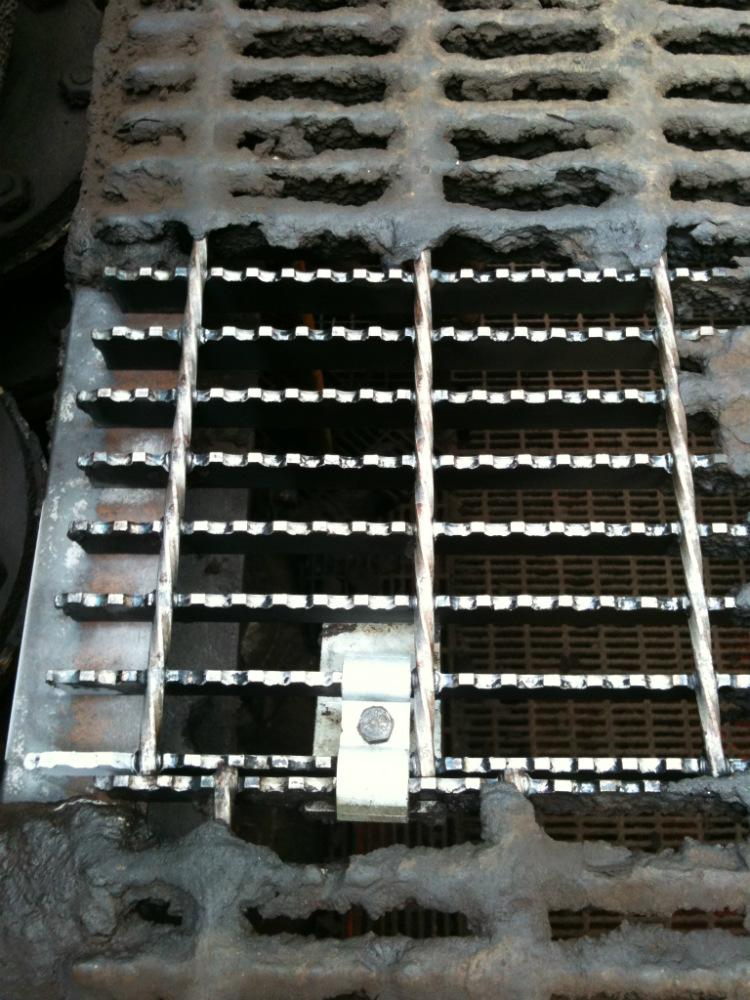Director Global Training & Development
- FMA
- The Fabricator
- FABTECH
- Canadian Metalworking
Categories
- Additive Manufacturing
- Aluminum Welding
- Arc Welding
- Assembly and Joining
- Automation and Robotics
- Bending and Forming
- Consumables
- Cutting and Weld Prep
- Electric Vehicles
- En Español
- Finishing
- Hydroforming
- Laser Cutting
- Laser Welding
- Machining
- Manufacturing Software
- Materials Handling
- Metals/Materials
- Oxyfuel Cutting
- Plasma Cutting
- Power Tools
- Punching and Other Holemaking
- Roll Forming
- Safety
- Sawing
- Shearing
- Shop Management
- Testing and Measuring
- Tube and Pipe Fabrication
- Tube and Pipe Production
- Waterjet Cutting
Industry Directory
Webcasts
Podcasts
FAB 40
Advertise
Subscribe
Account Login
Search
Cleaning automated weld lines with dry ice
Lose the cleaning chemicals; get the line up and running
- By Tyson Marlowe
- October 19, 2017
- Article
- Shop Management
Automated weld lines are difficult to clean and maintain. The most common issue is weld slag, spatter, resin, soot, grease, and other material building up on the robot joints, jigs, and other ancillary equipment. This buildup makes it difficult to perform regular maintenance on the equipment and reduces the robot’s range of motion.
Buildups cause misalignment and can prevent the proximity switch from firing in the appropriate spot. When this happens, the robot stops welding or welds incorrectly, which creates scrap and causes the equipment to fail. The production line may have to be shut down to correct the problem, and shutdown multiples preventable production costs.
Also, during traditional preventive maintenance, skilled electricians and mechanics spend a disproportionate amount of time cleaning troubled areas rather than focusing on items requiring repair.
Traditional cleaning methods are time-consuming, labor-intensive, costly, and not fully effective. Manual scraping and scrubbing with wire brushes using water or chemicals can consume many hours and cause downtime, damage equipment, shorten asset life, and reduce asset utilization rates. It also can be potentially harmful to employees.
Dry ice cleaning eliminates the negative effects of traditional cleaning methods and enables employees to quickly clean weld line production equipment in place. It allows for complete online cleaning, reduces scrap, helps prevent equipment damage, and maximizes tooling life.
The process can easily clean slag, spatter, soot, grease, and resin from robot joints, transfer cases, shuttle jigs, diamond plates, trunnions, weld tables, and fixtures.
What Is Dry Ice Cleaning?
Dry ice cleaning is similar in concept to sand, bead, and soda blasting in that it cleans surfaces using a media accelerated in a pressurized airstream. It differs in that it uses nonabrasive, solid CO2 pellets or CO2 microparticles accelerated to high velocities to impinge on the surface and clean it. Sublimating upon impact, the particles lift dirt and contaminants off the underlying substrate without damage and without leaving any residue behind.
The unique characteristics of dry ice make it ideally suited for cleaning production equipment on an automated weld line.
No Secondary Waste. Cleaning with dry ice enhances sustainability efforts. It sublimates (turns from solid to gas) upon impact with the surface being cleaned, which results in no secondary waste, no residue, and no moisture introduced. This eliminates extra cleanup; disposal of secondary waste streams; and additional cleaning preparation, such as masking delicate sensors or wrapping electronic components before cleaning.
Using dry ice as a cleaning media is environmentally responsible and does not add CO2 to the atmosphere. The process recycles existing CO2 by phase-changing it from gas to liquid to solid to gas.
The cleaning process requires no water, which allows equipment to be cleaned while online and operating. Because dry ice is non-conductive, it is safe for cleaning electrical equipment.
Nonabrasive. Dry ice is a powerful cleaner, but because it is a very soft media, it can clean even sensitive electronic equipment and around welding tips without etching, profiling, or changing surface dimensions.
Many production facilities are adopting a "no-contact” cleaning process in their maintenance programs. Dry ice accomplishes this initiative.
Nontoxic. Dry ice is a food grade media that is EPA-, FDA-, and USDA-approved. It is colorless, tasteless, odorless, and nontoxic. It has no environmentally harmful cleaning chemicals and eliminates worker exposure to hazardous cleaning agents. It produces no toxic waste for disposal.
Mobile. Dry ice cleaning machines are mobile and can be rolled right up to the robot or equipment being cleaned to maximize in-situ cleaning capability. Various hoses and nozzles also can be fitted to ensure reach.
Benefits of Dry Ice Cleaning
Using dry ice cleaning results in cost savings, improved productivity and product quality, extended equipment life, and improved worker safety.
Reduced costs. Dry ice cleaning reduces labor costs because it can be done quickly by one person and in significantly less time than by conventional manual means. This enables a cleaner clean, even on equipment that is difficult to clean by hand with conventional methods.
Improved Productivity. The process helps reduce shutdown times and allows for significant cleaning during a scheduled shutdown, as equipment can be cleaned while it’s hot and online without timely disassembly and reassembly. By cleaning equipment in less time, facilities are able to get more production cycles from existing equipment. Preventive maintenance or spot cleaning also can be done more frequently without affecting production. The entire weld line can be cleaned during a scheduled maintenance shutdown.
Improved Product Quality. Cleaning away slag, spatter, resin, and other grime that accumulates during normal operations helps to improve product quality, reduce scrap, and help maintain proper machine alignment.
Prolonged Equipment Life. Because dry ice cleaning is a dry, nonabrasive, nonconductive process, it does not damage equipment and is safe for most surfaces, including electrical components. Unlike traditional methods, it does not etch or nick the copper and brass fittings of the robot and jigs and leaves them with a like-new appearance.
It also can be used to clean around sensitive equipment, such as proximity sensors and photoeyes, without damaging them.
Improved Worker Safety. Along with eliminating exposure to toxic cleaning materials, the process also eliminates repetitive motions of hand cleaning or scrubbing, chiseling, and activities that require pounding, sanding, or scraping.
Dry Ice Cleaning in Action
An industrial service provider based in Lexington, Ky., performs critical process cleaning, maintenance, and support services to the automotive manufacturing industry nationwide. Automotive facilities often contract the company to clean and maintain their automated weld line robots and equipment. The company uses dry ice cleaning on these projects and has experienced cost and time savings.
Before implementing dry ice cleaning, the company manually performed the cleaning with hammers and chisels. Since implementing the dry ice technology, it has reduced labor hours per robot from 7.2 to 0.5 and overall labor time by nearly 70 percent. It also has reduced cleaning costs by up to 60 percent and reported an annual savings of more than $150,000 (for 38 robot cleanings per week) over the hammer and chisel method. It reported an ROI on its dry ice cleaning machine of 344 robot cleanings, or 2.3 months.
About the Author
Tyson Marlowe
455 Wards Corner Road
Loveland, OH 45150
(513)-831-3211
Related Companies
subscribe now

The Fabricator is North America's leading magazine for the metal forming and fabricating industry. The magazine delivers the news, technical articles, and case histories that enable fabricators to do their jobs more efficiently. The Fabricator has served the industry since 1970.
start your free subscription- Stay connected from anywhere

Easily access valuable industry resources now with full access to the digital edition of The Fabricator.

Easily access valuable industry resources now with full access to the digital edition of The Welder.

Easily access valuable industry resources now with full access to the digital edition of The Tube and Pipe Journal.
- Podcasting
- Podcast:
- The Fabricator Podcast
- Published:
- 04/16/2024
- Running Time:
- 63:29
In this episode of The Fabricator Podcast, Caleb Chamberlain, co-founder and CEO of OSH Cut, discusses his company’s...
- Trending Articles
Capturing, recording equipment inspection data for FMEA

Tips for creating sheet metal tubes with perforations

Are two heads better than one in fiber laser cutting?

Supporting the metal fabricating industry through FMA

Omco Solar opens second Alabama manufacturing facility

- Industry Events
16th Annual Safety Conference
- April 30 - May 1, 2024
- Elgin,
Pipe and Tube Conference
- May 21 - 22, 2024
- Omaha, NE
World-Class Roll Forming Workshop
- June 5 - 6, 2024
- Louisville, KY
Advanced Laser Application Workshop
- June 25 - 27, 2024
- Novi, MI





























